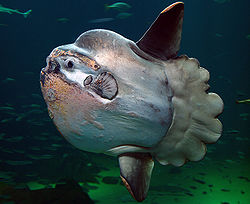Mola Mola
| Ocean sunfish | |
|---|---|
 |
|
| Scientific classification | |
| Kingdom: | Animalia |
| Phylum: | Chordata |
| Class: | Actinopterygii |
| Order: | Tetraodontiformes |
| Family: | Molidae |
| Genus: | Mola |
| Species: | M. mola |
| Binomial name | |
|
Mola mola (Linnaeus, 1758) |
|
The ocean sunfish or common mola (Mola mola) is the heaviest known bony fish in the world. Adults typically weigh between 247 and 1,000 kg (545–2,205 lb). The species is native to tropical and temperate waters around the globe. It resembles a fish head with a tail, and its main body is flattened laterally. Sunfish can be as tall as they are long when their dorsal and ventral fins are extended.
Sunfish live on a diet consisting mainly of jellyfish, but because this diet is nutritionally poor, they consume large amounts to develop and maintain their great bulk. Females of the species can produce more eggs than any other known vertebrate, up to 300,000,000 at a time. Sunfish fry resemble miniature pufferfish, with large pectoral fins, a tail fin, and body spines uncharacteristic of adult sunfish.
Adult sunfish are vulnerable to few natural predators, but sea lions, killer whales, and sharks will consume them. Among humans, sunfish are considered a delicacy in some parts of the world, including Japan, Korea, and Taiwan. In the EU, regulations ban the sale of fish and fishery products derived from the family Molidae. Sunfish are frequently caught in gillnets.
A member of the order Tetraodontiformes, which also includes pufferfish, porcupinefish, and filefish, the sunfish shares many traits common to members of this order. The ocean sunfish, Mola mola, is the type species of the genus.
...
Wikipedia

